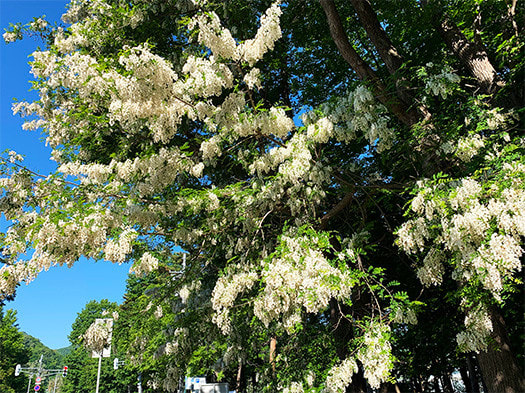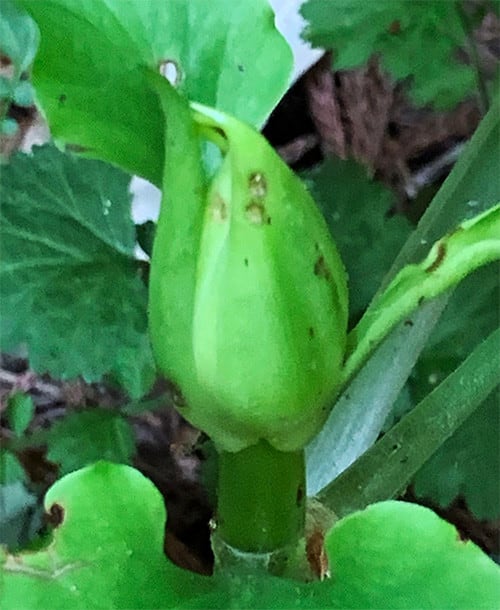

札幌は北国的なエキゾチック樹種が見られる北の街。
わたしの散歩道、円山公園〜円山山裾エリアではこの時期
オオウバユリの様子が目を楽しませてくれる。
隣接する三角山で春先にヒグマの巣穴が発見され逃亡というニュースがあり
わたしはことしは川の方にメインの散歩ルートを変えてきていましたが、
イキモノ同士の「虫の知らせ」みたいに呼び声を感じて
久方ぶりに円山山裾エリアを歩いてみました。
周辺ではいまちょうどアカシアも盛大に花を咲かせております。
札幌全域はこの樹の花粉が吹雪のように風に舞っている。
いかにも札幌のこの時期らしい雄大な情景が展開しております。
ひとつの花粉の大きさが4-5cmくらいはあるので、
大量に舞っている様子はちょっと幻想的とも思える。
目視する花の様子は札幌らしい初夏の空気感のなかで重量感がある。
子どもの頃からの体験記憶に刷り込まれている部分があって、
輪廻転生、諸行無常の機縁と感じられたりする。
年齢を重ねる毎に、こういうごく何気ない情景に深くとらえられる。
さて目当てのオオウバユリはようやくの初芽段階でした。
かれらは一定範囲で群生する生態のようで、
毎年、すこしづつ開花する個体の場所が違っているように思う。
こういう花芽段階からすっくと立ち上がっていくまでの様子が
いかにも「いのちの輝き」を訴えかけてくる。
花なんだけど、その挙動がいかにもイキモノ的で
半分以上はかわいい動物とも思える。
アイヌの人々のソウルフードでもある。
根茎部を採取し水にさらしてアクを取って粉にして料理する。
この列島で太古からいのちを繋いできた人間社会を
このオオウバユリは無言で語っているような気がする。
その様子がいかにも神々しくて神秘的とまで思えるのですね。

この写真は最近よく動き回っている市内中心部の石碑。
開拓の最初期、日本国家の基礎である神社信仰の中核として
この円山の裾野エリアに勧請された北海道神宮への道しるべ。
なんども見ているのに、この歳になってはじめて
「従是西二十八町」という側面の刻印文字を発見した。
いかにも「ボーっ」と生きてきたことがまざまざと思い知らされる(笑)。
札幌には「西二十八丁目」という地下鉄駅があるのですが、
偶然の一致であるのか、意図的なものなのか、
あらためて気付かされたのであります。
灯台もと暗し、こんな何気ないことがらから、
「歴史」というものは積層していく部分があるのでしょうね。
一昨日、北海道の高断熱高気密住宅探究の先覚者・荒谷 登先生が逝去。
よき住宅を目指し不断に進化してきた住宅の環境性能。
こういった努力もまた、歴史にやがて刻み込まれていくのでしょう。合掌。
English version⬇
Acacia, Lily of the valley, Sapporo in early summer, Rinne-tensho
The magnificence of the trees and flowers that convey the brightness of life as living things. Hokkaido's pioneering efforts to explore a better way of life through reincarnation. Hokkaido pioneering, an activity in search of a good life through reincarnation.
Sapporo is a northern city where exotic tree species can be found.
In my walking route, Maruyama Park to the foot of Maruyama Mountain, you can enjoy the sight of
The sight of the snow lilies in the Maruyama Park - Maruyama foothills area is a delight to the eye.
In early spring, a brown bear was reported to have escaped from its den on the neighboring Mt.
I had changed my main walking route to the river.
I felt the call of the bears, like a "bug alert.
I walked around the Maruyama area for the first time in a while.
Acacia trees are in full bloom in the area.
All over Sapporo, pollen from these trees is dancing in the wind like a snowstorm.
It is a magnificent scene typical of this time of year in Sapporo.
The size of each pollen is about 4-5 cm.
The sight of a large amount of pollen dancing in the air is a bit fantastic.
The sight of the flowers is heavy in the early summer air that is typical of Sapporo.
There is a part of me that has been imprinted in my memory of experiences since childhood.
I sometimes feel the opportunity of reincarnation and the impermanence of all things.
As I get older, I am more and more fascinated by such an ordinary scene.
The daylilies I was looking for were just at the first bud stage.
They seem to have a habit of growing in clusters within a certain area.
I think that the location of flowering individuals is a little different every year.
The way they grow up from the flower bud stage to the
The way they stand up from the flower bud stage is like a "radiance of life".
It is a flower, but its behavior is very animate.
More than half of them look like cute animals.
It is also the soul food of the Ainu people.
The rhizome part is collected, soaked in water to remove the scum, powdered, and cooked.
The aubayuri has been a part of human society on this archipelago since time immemorial, and it has been a part of the Ainu culture since the beginning of time.
I feel as if this day lily is silently telling us about the human society that has been sustaining life on this archipelago since ancient times.
It seems so divine and even mystical.
This picture shows a stone monument in the center of the city that I have been moving around a lot lately.
At the beginning of the pioneering period, as the core of shrine worship, the foundation of the Japanese nation.
It is a signpost to the Hokkaido Jingu Shrine, which was built at the foot of Maruyama in the early days of pioneering Japan.
I have seen it many times, but only at my age.
I found the engraved characters on the side of the sign,
It is a stark reminder of how much I have been living in a "daze" (laughs).
There is a subway station in Sapporo called "Nishi 28-chome."
I wonder if it is a coincidence, or if it was intentional.
I was reminded of this again.
It is dark under the lighthouse.
History" is a layered process, I suppose.
The day before yesterday, Dr. Noboru Aratani, a pioneer in the exploration of highly insulated and airtight housing in Hokkaido, passed away.
The environmental performance of houses has been constantly evolving in pursuit of good housing.
These efforts will be etched in history in time to come. Yours truly.










